Hybridfest and Beyond, 2007
Part two: A plethora of Prius parts, and a leisurely return home
Steve called me early the next morning, and suggested that I simply stumble
my sleepy self out of the campground and just across the street where there
was a good breakfast place where he and his daughter and I could fuel up for
the day. He was completely correct, and over coffee and correctly-greasy-yummy
stuff we immediately got into a groove of chatting about obscure Prius workings
and related topics. He's also a long-time electronics guy and used to run a
TV repair business, so the Prius appeals to both of us on many levels in a
very similar fashion.
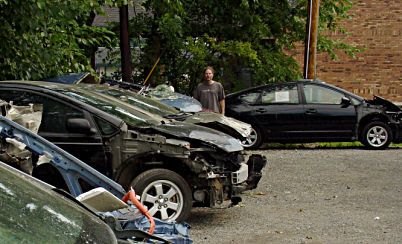
After breakfast we headed up to his workplace, and I found myself in his back
lot contemplating the row of Priuses in almost every conceivable state of
disrepair. Everything from minor fender-benders to almost unrecognizable
balls of crumpled metal.
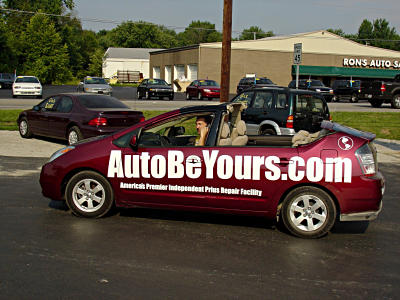
As Steve realized he had a free helper for a while, he asked me to come
with him to pick up another car from the painter's, so we jumped into his ...
*convertible Prius* [!] to zip down the road a ways. He put this together
partially as a rolling advertisement to bring to a local parade; in reality it
started as a car that a tree fell on so all that really took damage was the
roof. The solution? Chop it off and have an open-air Prius. He left the A
and B pillars in place to stiffen the chassis, and designed a shortened
mini-hatch door for the back to retain the look of the car's rear. A close
look shows the various places where the cut-off ends of the upper structure
are, but he's capped off the sharp bits with parts of interior plastic.
Unfortunately there's no ragtop roof [yet] so it has to be parked under cover,
and he said the air tends to howl strangely around in the space behind the
rear seats. But it's a great hack, and a street-legal way to run fair-weather
errands and draw eyeballs at the same time.
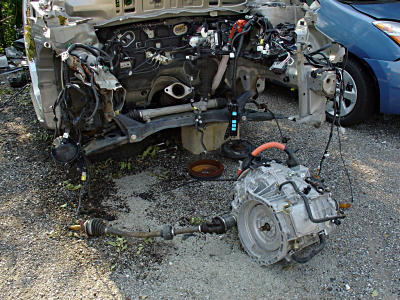
Many of the cars have been picked fairly clean by now -- not just removable
components, but large sections of body metal as well. A high proportion of
putting wrecked Priuses back together is bodywork, which involves grafting
still-good parts of cars into other cars and making all the sheet metal match
up. I'm still not entirely sure how this is done, but it was clear that
substituting things like the front ends of subframe rails is pretty common
since that's what gets bent up in a frontal. Along with that, there are many
good components to be taken off the wrecks and tested and organized. Here's
one with relatively little remaining, but there's still a bit of work to do
on it.
Possibly a good transaxle in front of it albeit with bent axles; it would be
worth checking the CV joints and half-shaft seals carefully and inspecting the
resolver and temp-sensor connectors which always seemed to get busted up in
collisions. And checking for water inside.
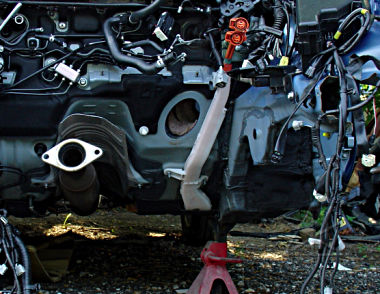
Another one in similar condition, but with even more of the front end gone.
Things like the exhaust system and battery cables and harness bits remain to
be recovered and maybe eventually go into another car.
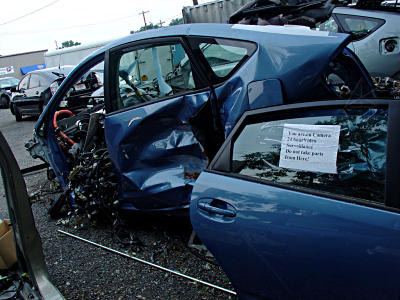
This side-impact might have been deep enough to be one of those instances of
battery-cable damage where the outer grounded shield gets used to detect HV
system faults, and where you'd want to use a high-voltage "megger" to test
them! Steve's been piling a lot of the harness parts of other cars into this
one for storage, since they're messy to try shelving elsewhere. The sign on
the window is no lie -- the whole yard is covered by cameras with digital video
recording and backed by a VERY deep buffer. Yes, he's had a few problems.
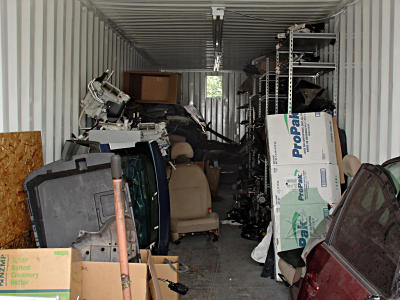
Many of the recovered parts get stored into a lockable container or shelves
in the shop, labeled as to source and any knowledge of condition. The trailer
has 100% solar powered lighting -- panels on the roof and a 12V battery and
inverter for the overhead fluorescents!
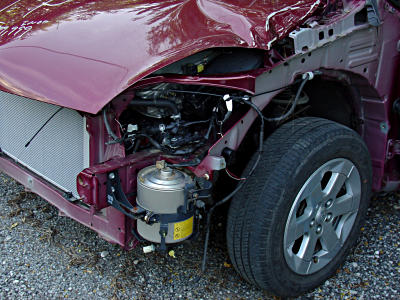
But many parts are still on the variously mangled cars, like wheels, radiators,
coolant pumps and storage bottles... hopefully not too mangled themselves.
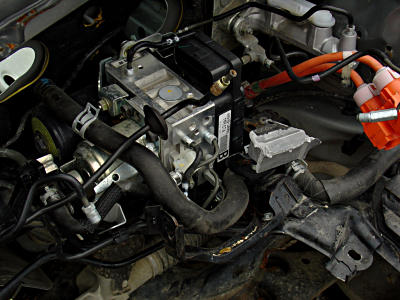
A brake actuator, for example, would be a very pricey item from a dealer.
One hopes this one is still good, as opposed to the remaining fragment of an
inverter case still hanging near it. Given how some of the hose fittings near
it are bent, it would be prudent to examine the threads on all the flare
fittings going into it, and of course do a complete flush [which is a rather
involved process].
Steve set both me and his daughter to the task of pulling more parts off a
couple of the already more stripped-down hulks. This is evidently part of
her summer job this year; possibly not what interests her the most but one
that if I'd known back then what I've learned recently, I would have killed
for! I did do the obligatory summer or two in a gas station back in the day,
but that was way before self-serve when one actually had to attend customers,
and there wasn't much opportunity to hang out in the bays and help the
mechanics with stuff. But here was a chance to totally soak myself in Prius
parts for a couple of days, and I dug in with gusto. It was nice to be able
to know what I was looking at and have a concept of its function and value,
and banter cluefully about the condition of things with Steve. The difference
is that he's got a much better idea of applying this stuff in a real-life
practical fashion. But sometimes he just doesn't have time to do that and
all the relatively menial labor of collecting and organizing all this stuff,
so he was appreciating the disassembly help.
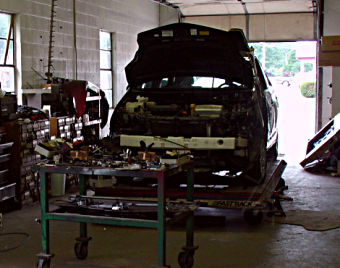
The shop is sort of a long single bay, with the most prominent equipment
feature being the alignment rack. No lift yet, but that's probably coming
soon. The car up on the rack that morning had apparently been rolled, and
had probably high-centered on a ditch edge at speed before going over because
there was lots of dried mud packed into almost everywhere under the front and
a clear pattern under the crossmember of having slid diagonally across dirt.
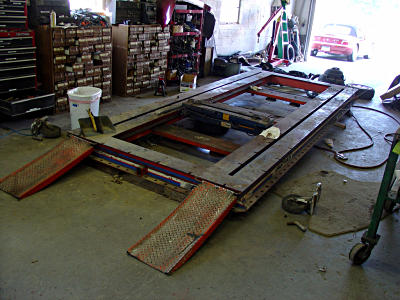
The rack normally sits up on large casters, so the entire thing with a car on
top can be pushed around the shop. It's basically a very stiff, strong flat
frame onto which various hydraulic clamps can be attached to pull, push, and
hold pieces of car bodies very firmly. There's a large air-powered scissor
jack in the middle that can slide back and forth, so it almost works like a
lift too. Later on, Steve jacked the front of the whole rack up [to remove
the casters] and then down onto a couple of 4x4s, sort of like kneeling a
camel, to attach the little ramps and swap that car off the rack.
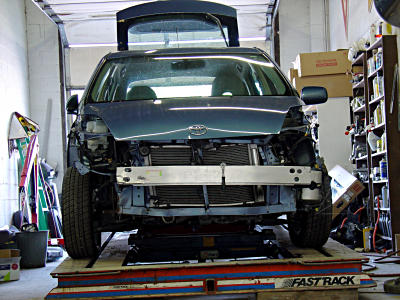
Next up was this one, which came with sort of a sad story -- a car that Steve
had fixed the front end of and sold to a local lady, who later got in an
accident that knocked the whole front end askew *again*. The little side
benefit is that Steve got to see his welding work seriously stress-tested,
and found that it held up fine. But the bumper is clearly offcenter and the
radiators are probably toast. Steve says that for these wrecks that look like
a hopeless mess even if relatively minor, one should just break it down piece
by piece and evaluate it one thing at a time, to avoid stressing about the
whole job.
We had taken some of the morning to disassemble the nose of this one, and I
found shreds of someone else's tire embedded in the chewed-up end of the
aluminum bumper piece. I was all set to take that off too, but Steve wanted
it left on as a straightening/spacing guide between the two rails. The car
still ran well enough to make the short trip onto the rack under its own power.
Steering was a little squirrely, and a close look shows that there's way more
toe-out than just the picture's perspective.
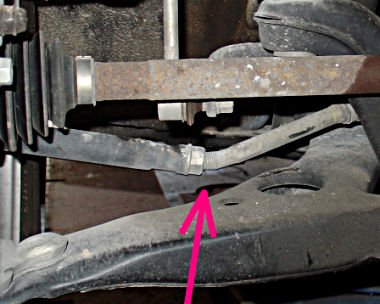
The reason? This steering tie rod, bent *way* out of shape. The rest of
the suspension around this wheel looked okay, so I can't imagine how enough
compressive stress happened to do this without, for example, turning the
rim into a pretzel and bending other parts. Measurements are obviously
needed, but Steve expressed high hope that all of this would be set straight
again fairly soon.
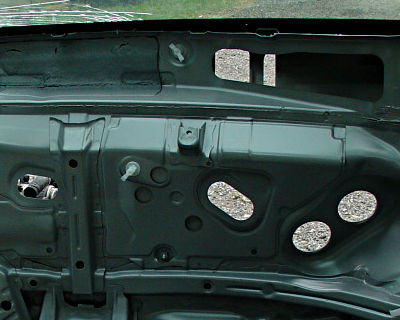
Back out to the yard for a look at a few more things. This is what the
firewall looks like when completely stripped of everything attached to it,
including the fiber sound dampening mats. Here it's easy to see what the
inner intake opening into the A/C and heater box looks like, and why it would
be difficult to install a piece of rodent-proofing mesh over it from outside --
because it's more than half blocked by the outer cowl piece and it's all firmly
spot-welded in place. To do that job right you'd have to pull the whole A/C
and blower unit -- which Steve has done during teardowns, of course, but not
what your typical shadetree owner is likely to tackle. It's much easier to try
and remember to leave the system in "recirculate" when shutting down, to avoid
having decaying mouse parts flying out of the ductwork when the fan starts up.
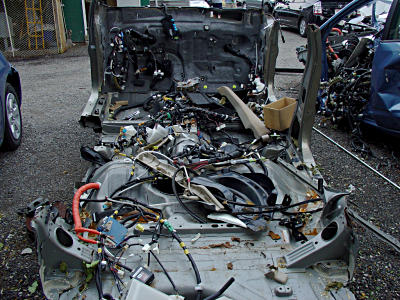
This chassis has had numerous sections cut off it, and there's very little
top structure left. Steve had decided that it was time for the rest of this
one to go to steel recycling and make room for another car coming in, so the
task was to finish stripping everything off. We cleaned up all the wire and
junk lying on top, extracted the steering rack and the few remaining items
clinging to the front of the firewall, and then the idea was to raise it and/or
flip it over to recover the exhaust system and battery cables. Steve later
managed to access all that by just jacking it up a little higher and adding
more cinderblocks. The shell wasn't very heavy to begin with; I could easily
lift the whole back end of it.
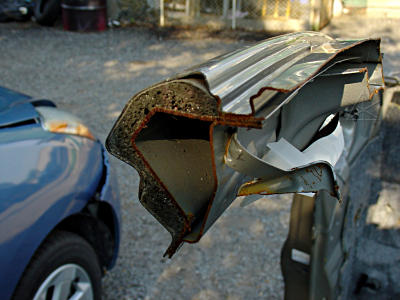
The cross-section cut of the A-pillar on this one reveals some interesting
construction details. Most of the major members have vibration-deadening foam
layers stuffed in. The thicker steel in the middle is the special hardened
stuff that forms the occupant protection cage, and Steve says it's very
difficult to cut. Now, note that this particular member is the piece that
passes most of the way over the driver's window but the B-pillar is gone,
and the remainder is only attached to the rest of the hulk at the front end
by the two pieces that bracket the little triangle window. Still, it felt
*very* stiff, so I figured I'd give it a little stress test.
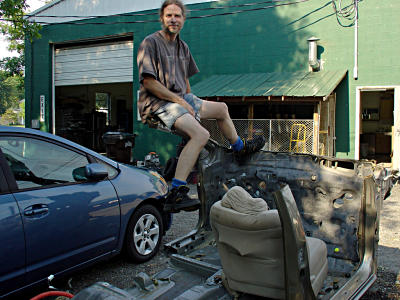
No deflection at all with 140-some pounds sitting [and bouncing] out on the end
of the lever arm. Those front triangle windows may look goofy, but they allow
for a serious strengthening truss at the bottom of that very slanted A-pillar.
That's probably why the rolled car had surprisingly little structural roof
damage.
The crunched seat is what came out of the "convertible", and got moved into
here after the big cleanout to be disposed of along with the hulk since it's
more or less non-recoverable.
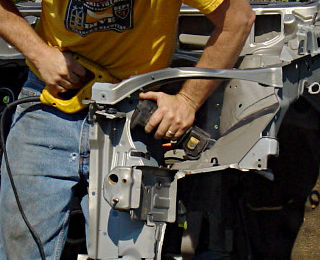
This is what happens when you give guys like this power tools... after pulling
the crossmember off to save the non-bent lower arm and free up the battery
cables, Steve looked at the subframe piece that connects to the bumper, said
"that's worth saving" and went to work. This is how he collects so many Prius
pieces that he can use to restore other cars to non-crunched condition.
I was amused to note that the rim supporting the hulk [pink, lower right, big
picture] had a Hydroedge tire on it.
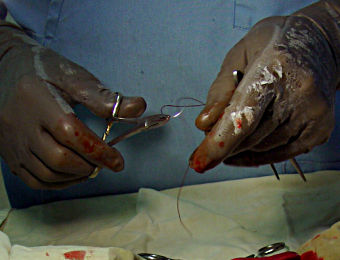
While the Sawzall was slicing and dicing, Steve's dad was inside taking
something else apart. WARNING: not for the squeamish! Steve shares building
space with his dad's veterinary practice -- an odd mix, but seems to work.
In fact, I think this was the second spaying operation that took place that
day. What I found fascinating is how dogs can still randomly yip and bark
while totally out of it under certain types of anaesthesia. Steve's dad also
made us really awesome lunches with grilled steak and local corn both days I
was there.
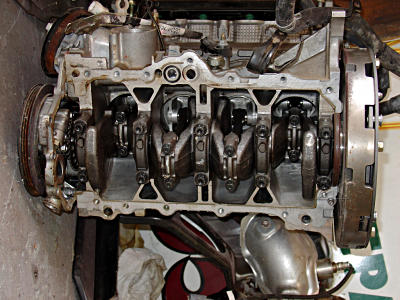
I finally found a partially disassembled engine kicking around. This is what
the big end looks like with #1 at top dead center...
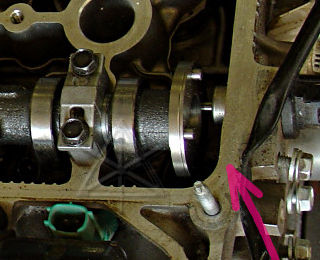
and where the cam sensor is at the same rotational position. This is at full
valve *advance*, and the sensor pin seems to line right up with the center of
the reluctor. Any more retarded position places the cam slightly more, uh,
clockwise as we're looking at it here. While the cam sensor may match a
sensible position at TDC, recall that the crank does not, but this may help
determine more about the relationship that the ECM does its calculations from.
Easy to see the longer-duration Atkinson intake cam here, and how the bucket
lifters fit snugly into little guide channels underneath.
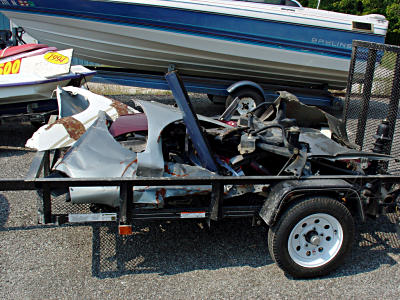
Besides stripping the cut-up hulk, Steve was doing a bunch more housekeeping
by piling other non-usable parts on the trailer [towed behind a Prius, of
course] to haul to recycling. It still seems too bad that a minorly bent rear
axle beam is now scrap, but it's probably safer to just replace it. And all
the crumpled fenders are simply toast.
Now, you'll notice a boat and a jet-ski behind here, too. Steve's vehicle
enthusiasm extends beyond Priuses, and he's got a few other toys of his own.
At the end of the first day he decided that we should use the rest of the
daylight to go jet-skiing. So we headed off to his house to pick up his truck
and trailered pair of boats and continued on to nearby Hardy Lake, where after
a nominal bit of instruction I got my first jet-ski experience. They're fun,
albeit in a fuel-sucking way. Water-going motorcycles. Roll on the throttle,
and they basically *launch* themselves across the water up over 50 mph very
quickly and are surprisingly stable given how small the hulls are, even over
small waves. They seem to rev-limit to their 8000 RPM redline. The jet pivot
and steering configuration does some magic thing that causes the boat to lean
*into* turns just the right amount so you can basically spin on a dime at lower
speeds. There are limits; you can't whip a turn at high speed because the hull
is higher off the water and it'll slide sideways a certain amount -- too far
and you'd take a high-speed high-side dump into the drink. No, no mishaps
occurred but I did play with cutting as tight as I dared before feeling the
slip starting.
Fuel conservation in a jet-ski?? Hah. To put it bluntly, there is no coasting
on those. Roll off the throttle and it just falls on its face -- fwooosh, and
you're right back down to idling-putter speed. It doesn't begin to get "on the
step" until about 20 mph when the hull begins to rise out, but that's about it
for any efficiency increase you might see. It simply takes a *lot* of energy
to push anything through water.
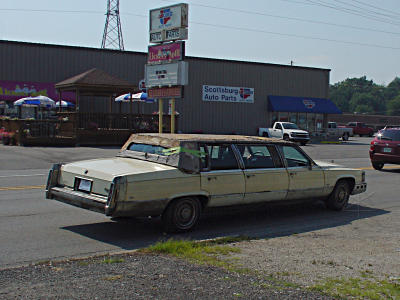
Steve's vehicle collection reflects how he's spent a long time doing the buy,
fixup, and resell game with many different types. This monster, for example,
had been in a fire in the surrounding building where it was parked, which
pretty much toasted the landau top and blackened the entire exterior. But
since the car was closed tight and the fire hadn't been that hot, nothing on
the inside got burned or even smoked up -- while I could smell smoke around the
exterior, I couldn't detect anything on the inside velvet upholstery -- pretty
amazing, when you think about it. The car still runs, and basically just needs
new trim, more cleanup, and a paint job. So while I was there Steve sold it to
his nephew and buddy who were looking for a large vehicle for their band's
gear, and here they are happily tooling off in their new acquisition. [Cue
the "Peter Gunn" theme...]
On the second day I was there, Steve also won a salvage-yard auction on almost
the inverse case from the limo -- a large motor home that had had a furnace
fire *inside* which charred much of the interior and put a big hole in the
roof, but remained otherwise functional. A couple of days after getting back
on the road, I got mail that he'd picked it up and driven it back to the shop.
So that's going to become another big ol' project!
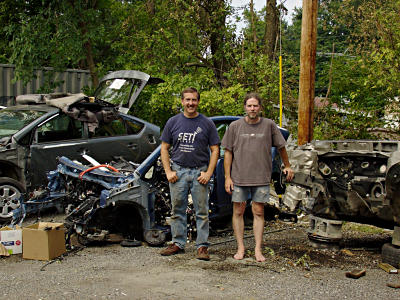
While I could have stayed on the rest of the week, or maybe the summer, I
started to feel a pull back toward the road and I'd already lined up my next
major waypoint in the DC area. So it was time to get rolling again; I used
the second evening's opportunity of Steve wanting to have family time to take
my reluctant leave and planned to get as far east as I could that night and
then explore some backroads on the way into Virginia the next day. Before
parting, Steve wanted a shot of both of us amid the tangle o' Prius. I'd had
a seriously good time here, and I know there's a lot more I could still learn
from him and what he does. I'll never look at Prius body parts quite the same
way again, that's for sure.
[For the record, I did wear work boots during most of my stay
there -- this was taken just as I was getting ready to leave!]
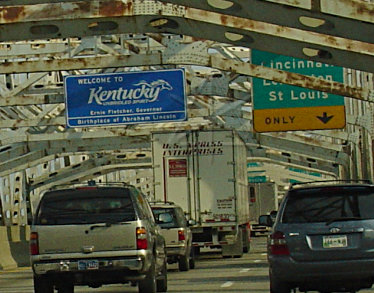
I dropped a little farther south into Louisville KY [via its rush-hour jam-ups
across the bridge] to pick up I-64 east. The welcome sign doesn't lie; like
most of Indiana is endless cornfields, western Kentucky really is endless horse
farms. Huge, rolling pastures with meticulously maintained fences.
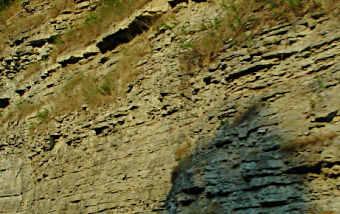
According to Steve, the IN/KY border is around where the ice-age glaciers
stopped advancing and left big piles of rock as they retreated. Most of the
bedrock seems to be this oddly stratified stuff, which is also ripe cave
formation territory. The hills formed by all this segue into the Appalachians
farther east, and that's where I was headed. I had planned a tentative route
into and through the fabled West Virginia mountains, by looking for the most
wiggly highways on the GPS, figuring those would be the ones that wind through
the highest hills while still getting me farther east.
I made the WV border by nightfall and continued on a little way, and somewhere
around the town of Hurricane started looking for a place to hang it up for
the night. After threading my way carefully through the maze of "sleeping
giants" at a TA truck stop and deciding it was just too loud with all the
idling diesels around, I backed quietly into an empty slot behind a Hampton
Inn across the street, rigged the curtains, and found that their Wifi covers
the parking lot well enough that I could hop on briefly and update the
running blog thread.
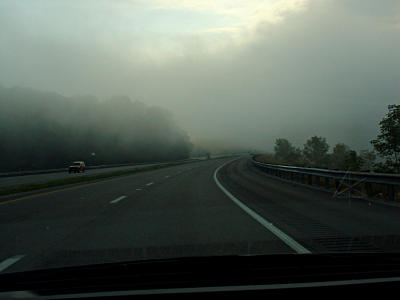
Got going again early the next morning, cruising through patches of that
infamous Appalachian fog that hangs in the valleys. After a while on the
interstate I branched off onto US33 eastbound, which for all intents and
purposes is every bit as fast as an interstate with two lanes each way and
a full median. Although every so often it necks down into a twistier two-lane
where it hasn't been expanded yet -- just the type of road I was looking for.
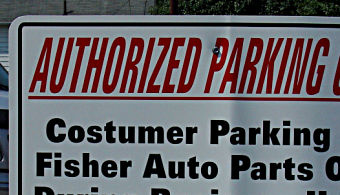
A sign in Elkins, WV [el. 1950 ft ASL], where I stopped to fuel up -- sort
of an in-joke to a bunch of us who do volunteer production tech for
masquerades at science fiction conventions.
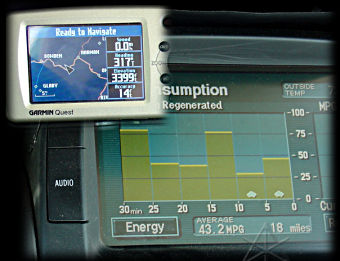
Past here the road becomes even more wiggly on the map, and rightly so, as I
got into a long climb up over the ridge east of Elkins. Note the elevation
here, helping explain why my fresh tank average rapidly descended into gas-
guzzler territory despite taking it easy and simply thumbing the occasional
pickup on by who actually *wanted* to make the climb at full throttle. But
even the minor MPG hit was well worth the view from the top:
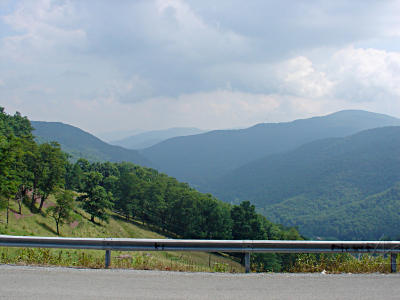
Sure, I could have blasted up the same hills at or over the posted 45 or 50 mph
speed limit -- the car's capable of it, but why bother? The Prius generally
doesn't bring the battery in to assist on acceleration until somewhere north
of 3000 engine RPM. So by holding right around there and letting a *little*
pack energy come in to help, I could keep a reasonable climb rate going all
the way up without getting too far into serious fuel-sucking territory, and
try to regulate things so the pack was largely drained at the crest. I figure
that's about 40 horsepower used to climb, which is still a higher power-to-
weight ratio than most trucks. What more does *anybody* need, unless they're
on some kind of emergency call.
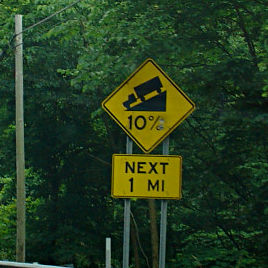
Without being too ridiculous, it's good to try and empty the pack at the top
to leave plenty of headroom for what comes next. Because the backside will
definitely fill it right back up no matter what you do, and once that happens
it's brake and B-mode for the rest of the downward scream.
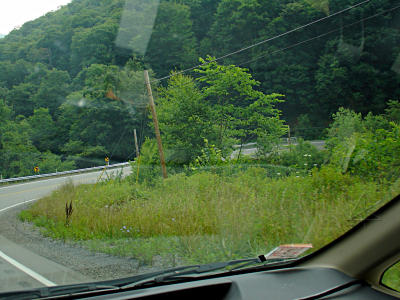
While it would be theoretically lovely to just ride it out in warp-neutral,
that's impossible when you also have to deal with switchbacks in the middle!
And there's usually a town at the bottom of the valley, where speed limits drop
to 25 mph. This is the fun "Prius in the mountains" game, especially on the
stock battery, and the object is to minimize overall energy loss regardless.
I continued eastward over several more ridges, topping the pack at least three
times in the process, but trying to balance pure regen vs. a certain amount of
throwaway by spinning the engine and braking.
Here's another reason to not blast up the hills at full bore. On another climb
later on, I was still having fun and being rather leisurely about it since the
road was still in a narrow two-lane section. I rounded another bend, and...

|
-- EEP!!
|
Fortunately nobody was behind me, and I was able to light the hazards to warn
off anyone who might come along, frantically grab the camera, and drift to a
dead stop and study them for a while. The fact that the car had fallen
completely silent helped, because now they didn't perceive me as an immediate
threat. So they wandered farther *into* the road, being only mildly leery of
this mysterious green alien pod that had just dropped out of hyperspace to
quietly observe them.
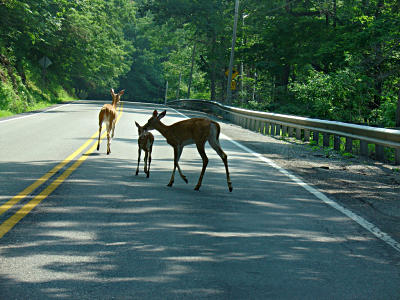
So I slowly chased them along the road under electric-only power a little ways,
until they finally figured out that maybe they shouldn't be there. The mom and
dad [?] managed to hop over the guardrail and down the bank; the fawn did a
clumsy but amusing little squeeze underneath. Meanwhile I was ready on the
high-beam lever to warn anyone coming down the other way, and kept half an
eyeball on the rearview in case anyone came sailing up behind and needed a
shot of the yuppie button to wake up and pay attention.
I was nonetheless really glad I was on the way *up* during this encounter,
or things may have gone quite differently. And glad that nobody else was
coming down at the time either.
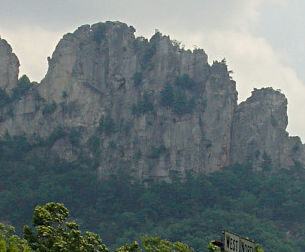
After that set of ridges I found myself at a crossroads near Onego, WV where
US33 turns abruptly south. I opted to turn north instead onto Rt. 28, since
that heads up toward I-66 more in the direction I needed to go. There is no
road continuing truly east from here, and I think we can see why.
As I contemplated all this from a general-store parking lot, the same small
group of bikers I had seen at a brief stop at the beginning end of US33 rolled
in behind me and we chatted a little bit. Even as a cager, I feel a little bit
of kinship with the 2-wheel crowd simply because we've all got our own ways of
enjoying our vehicles and these folks were clearly having just as good a time
on these roads as I was. They can make all the noise for me, though. My
excuse for not riding these days is simple -- it turned out that my car was
getting better mileage than my ol' 350 enduro putt-putt, so I eventually
sold off the scoot!
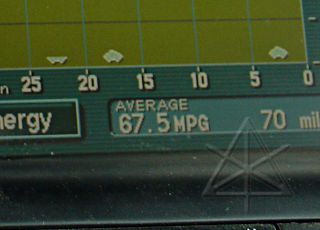
As 28 followed the valley northward and merged with 220, it yielded some
really long, beautiful engine-off glides while descending back down to a more
reasonable 800 feet ASL. "Now that's more like it!" I thought while noting the
recovering-and-then-some MPG average. In general, using a fairly consistent
driving methodology of staying within 2000 RPM plus or minus 300 with the
abovementioned excursions and grabbing as many warp-stealth and other no-fuel
opportunities as possible, the MPG average seemed to stay very closely and
simply tied to *altitude* over the entire trip. Maybe just a wee bit better
overall on the return leg due to prevailing westerly winds.
Soon I dropped onto I-66 and continued on toward DC and the house of an old
friend who'd just recently bought a new Prius.
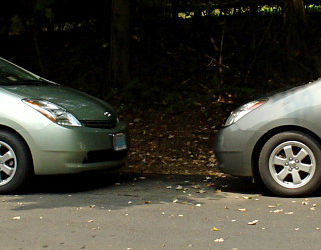
Booger? Meet your crazy old uncle. He's one of those hypermilers.
Over the next few days as I hung out there, she did most of the driving on
the minor errands we went out on [I still had no usable shotgun seat], and it
was quite clear that any sort of MPG clinic was not in the cards. But that's
okay; if it's gonna happen it'll happen by itself as time and continued Prius
ownership work their magic, and in the meantime we can simply agree to
disagree on style points.
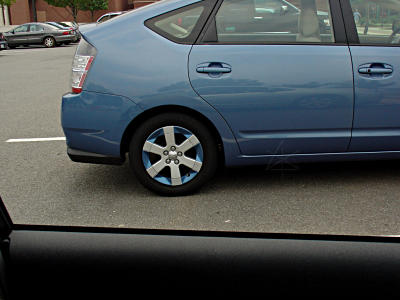
On one of our jaunts out to the fish store [she has way-cool saltwater reef
tanks] we spotted another Prius with an interesting color scheme on its trim
rings. Almost like the owner had seen this photochop and had decided to
experiment, but in the car's own color instead of black.
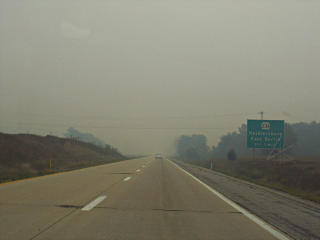
Finally it was time to start the final leg to home. As I wandered my way up
through Maryland into Pennsylvania [avoiding the I-95-corridor mess, well worth
it], the humidity became more and more oppressive with just enough sun leaking
through to make things really hot and miserable. I finally caved in and
switched to using the A/C just to try and dry the air around me a little bit,
figuring it would be a big MPG hit. But with the system set at 76 and medium
fan, the average didn't seem to drift any more than I would have expected from
terrain. So modest A/C seems about equivalent to the two-diagonal-slits trick
and probably keeps the HV battery a little happier anyways.
A couple more little vignettes from the road...
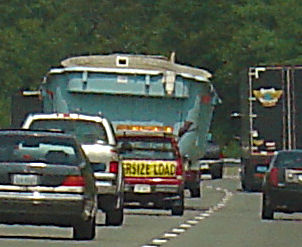
As I got into the part of I-81 that heads over the ridges in PA, I was passed
by a flatbed load of ... swimming pools. Mind you, I was still doing sixty
or better MPH on average, so I guess someone *really* wanted to get their pool
installed right now.
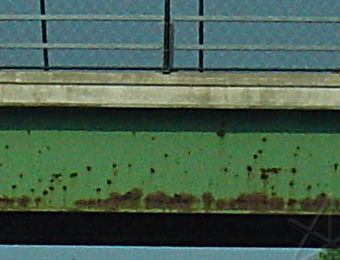
It is interesting where the rust tends to collect on steel bridge beams. The
pattern of where the most corrosive gases drift up against the overpass is
fairly obvious on many of them. Maybe someday we'll wise up and quit
generating nearly so much of that stuff.
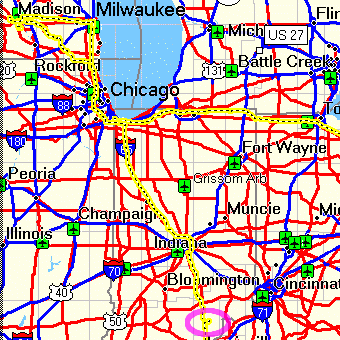
Here's the whole loop -- 2950 miles or so, in yellow. The little pink oval
is about where Scottsburg is. Fillup average over 5 tanks was 61.7 according
to the car, or right around 61 MPG taking my known +1.2% Hydroedge distance
factor into account. Try *that* in your Winnebago...
_H* 070806









































